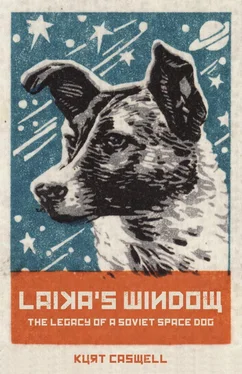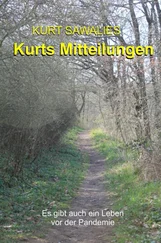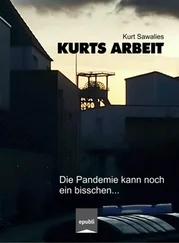In 1961 Van Cliburn came again to Moscow to perform, for he so loved the city and the nation. While he was recording a live performance at the Shabolovka broadcasting center, Belka and Strelka were featured TV guests in a nearby sound studio. Wily little things that they were, the two dogs escaped their handlers and scurried off through the hallways of the building. “We were at the Shabolovka studios where they were filming the dogs,” said Institute of Aviation Medicine biologist Ludmilla Radkevich in an interview in Space Dogs . “The cameraman said: ‘Could they bark a bit? Make them bark. Do something for the cameras.’ But the dogs just sat quietly until one of the cameramen dropped something. Then the dogs jumped up and ran right out of the studio.” The two dogs slipped through a doorway and found themselves on stage with Van Cliburn. The great pianist recognized the dogs immediately and interrupted his concert to welcome them. “He was so delighted and happy he couldn’t believe his luck,” said Radkevich.
Van Cliburn posed for photographs holding the dogs. In one photo, he holds the dogs close against his chest, Belka in his right hand, Strelka in his left, a happy smile on his face, the studio lights putting a shine on his always-perfect hair. In Soviet Space Dogs , Turkina states that the incident made the evening news, the American prodigy poised in awe and admiration of the Soviet space dog heroes. The moment is a giant among the many instances of what the Soviet PR machine called “Victories of Soviet Science for the Sake of the Entire Human Race.”
Belka, who had already flown three times, and Strelka, who had never flown, made their historic flight on August 19, 1960. The team prepped the two dogs, attaching sensors to monitor heart rate and respiration. Their orbital flight was scheduled to last twenty-four hours, so their space suits included a waste management system, and their capsule, a food dispenser. Sensors allowed the ground crew to monitor the air quality inside the capsule, its carbon dioxide, oxygen, and water vapor levels, while TV cameras monitored the dogs in real time. Also along for the ride: rats, mice, insects, fungi, various plants and sprouts of wheat, peas, onions, and corn, and, according to some sources, a rabbit.
The team watched the video stream of the dogs in the capsule as the R-7 rocket lifted off. Belka and Strelka were pinned down by the g-force of acceleration. They looked almost dead, or dying, it was hard to tell. Their heart rate and respiration rose dramatically, even tripling, which let the team know the dogs were still alive but obviously in distress. And then the spacecraft entered orbit and that soft elevation of microgravity collapsed over them. Their vital signs normalized. They began to stir, to move inside the capsule a little, and then Belka started barking. The team on the ground could not hear her, as the microphones they installed were only able to detect the background noise inside the spacecraft, but they could see her. She struggled and barked in that weird absence of gravity, nothing like the environment her body had evolved in. So she barked. A dog barking in space. The spacecraft came around the Earth for the fourth time, and Belka vomited. That done, she settled down and seemed to accept what was happening to her. As her body adjusted to microgravity, she went along with the ride. There was nothing else she could do.
It’s likely that Belka’s distress and vomiting were caused by what researchers now call space adaptation syndrome, the effect of moving rapidly from the hypergravity environment of launch to the microgravity environment of space. This shift causes an increase in cranial pressure, which can lead to headache, vertigo, a general feeling of malaise, and vomiting. The condition affects about 50 percent of all astronauts who fly in space. Yazdovsky and his team were observing these effects for the first time and acknowledged that there were just too many unknowns about microgravity. They recommended the first human in orbit make no more than one trip around. The recommendation held, and this is precisely what Gagarin did.
After eighteen orbits in a period of some twenty-five hours, the spacecraft carrying Belka and Strelka made its reentry into Earth’s atmosphere. The capsule the dogs rode in was ejected from the spacecraft and came down under a braking chute. It landed off course in the steppe near the Russian city of Orsk at the southern tip of the Ural Mountains, that great sweep of temperate grassland where, some six thousand years ago, the horse was first domesticated, revolutionizing the way we live and work, hunt and fight. The recovery team found the capsule and opened it. Inside were Belka and Strelka in perfect condition. Once released from their restraining harnesses, the two dogs ran about the search and recovery team barking and leaping into the air.
Belka and Strelka were interviewed on Radio Moscow and put on display at a press conference at the Academy of Sciences. In a now-famous photograph, Gazenko holds the two dogs aloft, one in each hand, the look of triumph in his smile and eyes, a lighted candelabra in the foreground. There was no doubt, in that moment, that Belka and Strelka’s success would not have been possible without Laika’s death.
In November of that year, Strelka gave birth to a litter of six puppies sired by Pushok, a space dog who never flew. Khrushchev gave one of the pups, Pushinka (Fluffy), as a gift to America’s first family, the Kennedys. Pushinka was a gift of political and cultural goodwill, but also a kind of gloat: see what the Soviet Union has achieved! Before joining the Kennedy family in the White House, Pushinka endured a thorough inspection, which included X-rays, to make certain she was not bugged or surgically implanted with some explosive device. Little Pushinka, the Russian debutante, later fell in love with one of the Kennedys’ dogs, Charlie. They had a litter of pups, American-Soviet mutts the Kennedys named Butterfly, Streaker, White-tips, and Blackie. President Kennedy called them pupniks.
¤
With the flight of Belka and Strelka, the space dog program was coming to a close. The Soviets knew it would not be long before they sent a man into space, and then the kind of work the dogs were doing to test life support and recovery systems would not be needed anymore. This was not, of course, the end of biological and medical research in space using animals. Such research is ongoing, but cosmonauts would soon become both scientist and test subject. Another factor pushing the end of the space dog program was a growing criticism by both animal rights organizations and the general public. People just didn’t want to hear news of flying dogs, and especially news of those dogs dying. Fruit flies? Mice? Fungi? No problem. But dogs, the animal we love best, our companions and friends? Too cruel. Not ethical. Inhuman.
Mukha (Little Fly) and Pchelka (Little Bee), along with guinea pigs, rats, mice, fruit flies, and some plants, lifted off on December 1, 1960, aboard Sputnik IV for a flight that was to last one day in orbit. Mukha had already had two near misses on her life: she had been passed over for Laika’s doomed mission, and she nearly died during her three-day test of Laika’s capsule. Now she was going to risk it all again. During the flight, TV cameras onboard the spacecraft broadcast a signal back to Mission Control at eighty-three megacycles. The CIA demodulated the signal and watched footage of the two dogs during their flight. It was becoming harder and harder for both the US and the USSR to keep their programs, and their technology, secret from each other. When the spacecraft reentered Earth’s atmosphere, the retro-rocket, designed to slow and guide its trajectory, malfunctioned. It fired and kept firing, and it would not shut down, sending the spacecraft far off course. Mission Control was no longer in control, and it looked like Mukha and Pchelka would land outside the Soviet Union. To avoid a foreign government getting ahold of their spacecraft and their dogs, Mission Control destroyed it with a remote self-destruct feature, sending a fiery trail across the sky. Both dogs were killed.
Читать дальше












